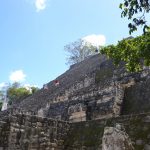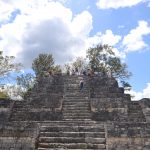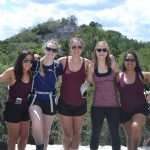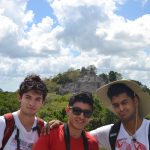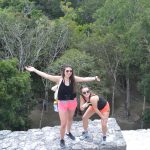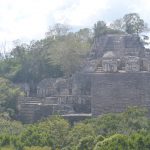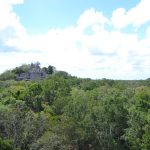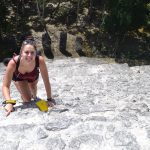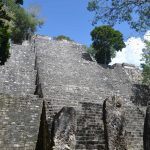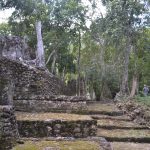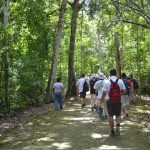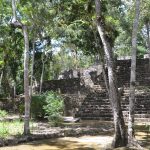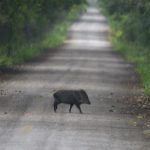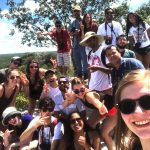Hello friends, family, and all other followers of our travels!
Today was our earliest day yet. We woke up and went straight to the bus to leave by 7:30am (okay maybe it was a little closer to 8:00am by the time everyone made it to their seats on the bus). We trekked about 1 hour before making it to the turnoff through to the road to Calakmul through the lands of the Conhuas Ejido. We travelled another hour before reaching the Calakmul Archeological Site. This is an ancient, now-abandoned, Mayan city that dates back to the Preclassic (300-250 AD) and Classic periods. The site is recognized by UNESCO as part of the World Heritage List of the Convention concerning the Protection of the World Cultural and Natural Heritages. The site is also part of the Calakmul Biosphere Reserve. Dr. Lougheed invited us to contemplate why a city that, at is apex housed 50,000 people, was abandoned – to think about water challenges in a limestone-based landscape, local weather patterns, and historical climate change.
On our drive to the ancient Mayan city, in the Biosphere Reserve, we saw about 5 collared peccary. Peccary are wild pigs found in Mexico that can be very aggressive and have large front fangs that can cut you (don’t worry parents, we were in the bus so no one was hurt). We also learned that the white-lipped peccary could use a tactic in which they surround their enemies, a lot like raptors used to do. We also saw a grey fox lying down in the middle of the road in front of our bus before he hurried off.
When we made it to the welcome centre of the archeological site we finally got to have our breakfast! Our hostel was kind enough to make us quesadillas and pack them up along with some fruit for the trip.
After breakfast we started our hike towards the city and the remaining, excavated structures found within what its now tropical forest. The first part of the city we saw was the housing complex “Taman” which showcased the remains of a stone building with stone benches in it (which would have been used as seats or beds for the Mayans). Next, we came across some steals; we ended up seeing many of throughout our time exploring the ancient city. Stelas are tall limestone rocks with carvings and writing in them that are commemorative monuments for the rulers of the Mayan city.
The first large structure we came across was Structure 7 and we found a small anole lizard climbing along with us. Archeologists believe that this structure was the tomb of a Mayan ruler. After seeing this structure we continued on and then were in awe when we saw Structure 2. Structure 2 is the tallest building (50 m) in the ancient Mayan city and one of the tallest Mayan structures ever discovered by archeologists. This structure was the heart of the city and the entry into it represents a cave connecting the Earth with the Xibalba (the underworld). When we got to the top of Structure 2 (a highly recommended workout) we could see the whole Biosphere Reserve and the entire area the ancient city would have covered. We could also see the twin structure that gives Calakmul its name of “two adjacent mounds” in the Mayan language.
After returning to the bottom, we got another great (gruelling) workout in by climbing Structure 1, the twin structure. From the top of this structure we could see all the way out to the Mexico-Guatemalan border this time, along with the rest of the ancient city and Biosphere Reserve. The structure is orientated in such a way that it faces the rising sun in the morning. Zafiro was also able to snag a cute little lizard on the way down!
On our walk out of the ancient city we saw a Yucatán howler monkey in one of the trees and back on the bus on the way out of the Biosphere Reserve we saw an ocelated turkey crossing the road, bearing beautiful colours.
Once back at our hostel in Zoh-Laguna we had “lunch” at 5:00pm and got a break to work on schoolwork for our other classes. We finished the day with dinner and listening to more seminars from both our fellow Canadian classmates as well as our new Mexican classmates. We were also very lucky to have guest speaker, David Enrique Sima (Project Coordinator for field projects in Calakmul) talk to the class about his research on jaguars and other large felids, and his methods on monitoring them using camera traps set near “aguadas,” both artificial and natural. These human-made water holes attract many animals during dry season, which is what we are experiencing right now (November to May is the typical duration of the dry season here in the Yucatan).
We can’t wait to see what we’ll be doing tomorrow!
That’s it for now. Thanks for reading and following along on our journey with us!
Español
Hola amigos, família, y todos los que están siguiendo nuestro viaje.
Hoy fué el día que nos levantamos más temprano. A las 7:30am estabamos en el autobús para la salida, aunque salimos poco después como a las 8:00am, ya que esperamos a algunos que no llegaron a la hora. Viajamos por más de una hora antes de llegar a reserva de la Biosfera de Calakmul, p osteriormentecomo otra hora más para llegar al sitio arqueológico. Calakmul es una ciudad maya que data del periodo Preclásico (300-250 DC) a clásico. El sitio es considerado como patrimonio mundial por parte de la UNESCO por su relevancia natural y cultural.
En camino a la Antigua gran ciudad maya, observamos un grupo de 5 pecaries, “puercos salvajes” que pueden llegar a ser muy agresivos y atacar con sus filosos colmillos (no se preocupen papás, estabamos en el autobus cuando los observamos). También aprendimos que pueden usar una estratégia en la cual pueden rodear a su enemigo, como los velociraptors lo hacian para atacar. Más adelante encontramos una zorra sobre el camino tomando el sol la cual salió corrinedo cuando nos acercamos.
Ya que llegamos al centro de visitantes de la zona arqueológica, nos organizamos para desayunar unas ricas quesadillas acompañadas de fruta y agua de Jamaica. Ya después del desayuno iniciamos nuestra expedición a la zona arquológica entre el bosque tropical subpernifolio. El primer edicicio que encontramos era grande, identificado como el número 7. Mientras la escalamos, encontramos una lagartija anolis. Los arqueologos propusieron que la estructura fue la tumba de un gobernador maya. Después continuamos a la estructura 2 y nos quedamos sin palabras al ver la grandeza del edificio, que según los arqueólogos es entre las más altas descubiertas (50m de altura) del mundo maya. Según la historia, la piramide fué el corazón de la ciudad y sus entrada a esta representa una cueva que conecta la tierra con Xibalba (el inframundo). Ya que llegamos a la cima de la estructura 2 (un ejercicio muy recomendado), pudimos ver la basta y extensa selva de la reserve de la biosfera de calakmul y el área que una vez cubrió la Antigua ciudad maya. Hacia el oriente pudimos ver la otra piramide gemela que le dá el nombre a Calakmul de “dos templos adyacentes” en el lenguaje maya.
Cuando bajamos de la piramide, fuimos en busca de la estructura 1, donde tuvimos otro buen ejercicio trepando nuevamente. Desde la cima, pudimos ver todo el bosque alrededor hasta la frontera con Guatemala y las otras piramides inmeras en el extensor bosque. Las piramides están orientadas de tal manera que por un lado encaran la salida del sol y por el otro la puesta. Cuando bajabamos, Zafiro atrapó una lagartija.
Ya cuando saliamos de la zona arqueológica, observamos un mono aullador descansando en los árboles y poco después sobre el camino, un Pavo ocelado de colores brillantes.
Ya de regreso en el hotel de Zoh-Laguna, estudiamos e hicimos tareas de otras materias, terminando nuestro día con otros seminarios después de la cena, presentados por nuestros compañeros de Canadá y de México. Tuvimos además una plática por un biólogo de nombre David que trabaja para la Reserva. Nos habló de su investigación con jaguars y la importancia de las aguadas y el uso de bebederos artificiales para ayudar a los animals durante el periodo de secas.
No podemos esperar a lo que viene mañana.
Eso es todo por hoy, gracias por leer y seguir las aventuras de nuestro viaje con nosotros.
